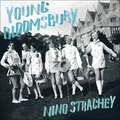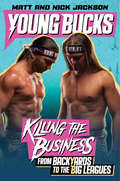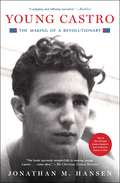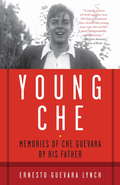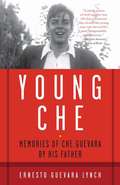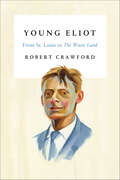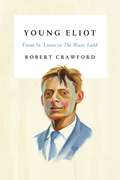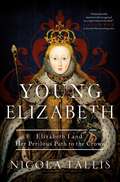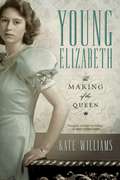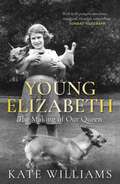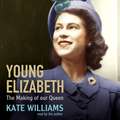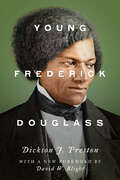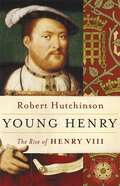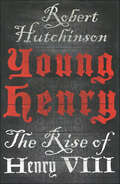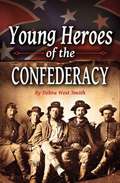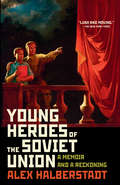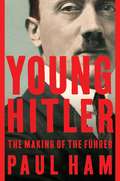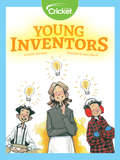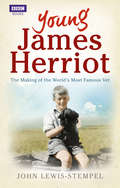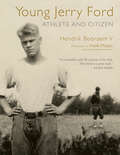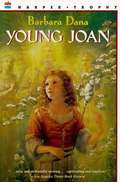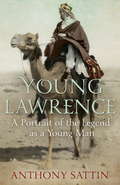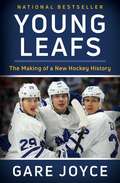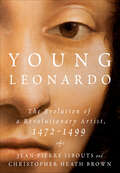- Table View
- List View
Young Bloomsbury: the generation that reimagined love, freedom and self-expression
by Nino StracheySurprisingly little has been written about second-generation Bloomsbury who tantalised the original 'Bloomsburies' at Gordon Square parties with their captivating looks and provocative ideas.Young Bloomsbury introduces us to an extraordinarily colourful cast of characters, including novelist and music critic Eddy Sackville-West, 'who wore elaborate make-up and dressed in satin and black velvet'; sculptor Stephen Tomlin; and writer Julia Strachey. Talented and productive, these larger-than-life figures had high-achieving professional lives and extremely complicated emotional lives. Bloomsbury had always celebrated sexual equality and freedom in private, but by the 1920s self-expression was becoming more public, with cross-dressing Young Bloomsbury giving Old Bloomsbury a new voice in a chosen family of a shared rebellion against pre-war conventions.(P) 2022 Hodder & Stoughton Limited
Young Bucks: Killing the Business from Backyards to the Big Leagues
by Matt Jackson Nick JacksonThe electric and daring independent wrestling tag team share their inspiring story of how two undersized, ambitious athletes from Southern California became the idols of millions of popular sports fans, coveted among the ranks of AEW’s elite wrestling lineup. Featuring over 60 photographs and alternating between each brother’s perspective, this entertaining memoir is a complete portrait of what it means to grow into—and give back to—wrestling, the sport and profession they embody and love.Famous for their highflying moves, Superkicks, and viral videos, Matt and Nick Jackson are two of the hottest and most talented competitors in professional wrestling today. Known as the Young Bucks, this pair of ambitious brothers are an inspiration to both fans and aspiring wrestlers worldwide due to their message of resilience and determination. That they are also faithful family men devoted to their loved ones gives them additional appeal.Young Bucks begins in Southern California, where two young boys grew up dreaming of success and fame. Matt and Nick look back on the sacrifices they made to achieve their ambitions, from taking odd jobs to pay for their own wrestling ring to hosting backyard events with friends. They share their joy at being recruited into the independent California wrestling circuit and the work it took to finally make it professionally, and speak frankly about what it means to have the support of millions of fans cheering their talents in arenas nationwide. The Young Bucks talk endearingly about their sport, their faith, and their families, sharing personal reflections and behind-the-scenes anecdotes while paying tribute to the wrestling acts and inspirations that came before them. They also elaborate on this historical time in the evolution of wrestling, as the sport and its culture dramatically change day by day.Told with the brothers’ signature wit and charm, Young Bucks is warm, heartfelt story of hope, perseverance, and undying ambition.
Young Castro: The Making of a Revolutionary
by Jonathan M. HansenThis intimate, revisionist portrait of Fidel Castro, showing how an unlikely young Cuban led his country in revolution and transfixed the world, is &“sure to become the standard on Castro&’s early life&” (Publishers Weekly). Until now, biographers have treated Castro&’s life like prosecutors, scouring his past for evidence to convict a person they don&’t like or don&’t understand. Young Castro challenges us to put aside the caricature of a bearded, cigar-munching, anti-American hothead to discover how Castro became the dictator who acted as a thorn in the side of US presidents for nearly half a century. In this &“gripping and edifying narrative…Hansen brings imposing research and notable erudition&” (Booklist) to Castro&’s early life, showing Castro getting his toughness from a father who survived Spain&’s class system and colonial wars to become one of the most successful independent plantation owners in Cuba. We see a boy running around that plantation more comfortable playing with the children of his father&’s laborers than his own classmates at elite boarding schools in Santiago de Cuba and Havana. We discover a young man who writes flowery love letters from prison and contemplates the meaning of life, a gregarious soul attentive to the needs of strangers but often indifferent to the needs of his own family. These pages show a liberal democrat who admires FDR&’s New Deal policies and is skeptical of communism, but is also hostile to American imperialism. They show an audacious militant who stages a reckless attack on a military barracks but is canny about building an army of resisters. In short, Young Castro reveals a complex man. The first American historian in a generation to gain access to the Castro archives in Havana, Jonathan Hansen was able to secure cooperation from Castro&’s family and closest confidants. He gained access to hundreds of never-before-seen letters and interviewed people he was the first to ask for their impressions of the man. The result is a nuanced and penetrating portrait of a man at once brilliant, arrogant, bold, vulnerable, and all too human: a man who, having grown up on an island that felt like a colonial cage, was compelled to lead his country to independence.
Young Che
by Ernesto Guevara Lynch"I had prepared a life plan that included ten years of wandering, later years studying medicine. . . . All that's in the past, the only thing that's clear is that the ten years of wandering might grow longer . . . but it will now be of an entirely different type from the one I dreamed of, and when I arrive in a new country it will not be to go to museums and look at ruins, because that still interests me, but also to join the struggle of the people." - Che Guevara, in a letter to his mother, 1956Assembled from two separate books written by Che's father, this is a vivid and intimate account of the formative years of an icon. Ernesto Guevara Lynch describes the people and personal events that shaped the development of his son's revolutionary worldview, from his childhood in a bourgeois Argentinian home to the moment he joined Castro to train for the invasion of Cuba in 1956. It also includes, available for the first time in the United States, Che's diary of his trip around Northern Argentina in 1950. Young Che is an indispensible guide to understanding one of the twentieth century's most famous and enduring revolutionary figures.From the Trade Paperback edition.
Young Che: Memories of Che Guevara by His Father
by Ernesto Guevara Lynch Lucia Alvarez De ToledoAssembled from two separate books written by Che's father, this is a vivid and intimate account of the formative years of an icon. Ernesto Guevara Lynch describes the people and personal events that shaped the development of his son's revolutionary worldview, from his childhood in a bourgeois Argentinian home to the moment he joined Castro to train for the invasion of Cuba in 1956. It also includes, available for the first time in the United States, Che's diary of his trip around Northern Argentina in 1950. "Young Che" is an indispensable guide to understanding one of the twentieth century's most famous and enduring revolutionary figures.
Young Clara Barton: Battlefield Nurse
by Sarah AlcottFollows the life of the nurse who served on the battlefields of the Civil War and later founded the American Red Cross.
Young Eliot: From St. Louis to The Waste Land
by Robert CrawfordA groundbreaking new biography of one of the twentieth century's most important poetsOn the fiftieth anniversary of the death of T. S. Eliot, the award-winning biographer Robert Crawford presents us with the first volume of a comprehensive account of this poetic genius. Young Eliot traces the life of the twentieth century's most important poet from his childhood in St. Louis to the publication of his revolutionary poem The Waste Land. Crawford provides readers with a new understanding of the foundations of some of the most widely read poems in the English language through his depiction of Eliot's childhood—laced with tragedy and shaped by an idealistic, bookish family in which knowledge of saints and martyrs was taken for granted—as well as through his exploration of Eliot's marriage to Vivien Haigh-Wood, a woman who believed she loved Eliot "in a way that destroys us both." Quoting extensively from Eliot's poetry and prose as well as drawing on new interviews, archives, and previously undisclosed memoirs, Crawford shows how the poet's background in Missouri, Massachusetts, and Paris made him a lightning rod for modernity. Most impressively, Young Eliot reveals the way he accessed his inner life—his anguishes and his fears—and blended them with his omnivorous reading to create his masterpieces "The Love Song of J. Alfred Prufrock" and The Waste Land. At last, we experience T. S. Eliot in all his tender complexity as student and lover, penitent and provocateur, banker and philosopher—but most of all, Young Eliot shows us as an epoch-shaping poet struggling to make art among personal disasters.
Young Eliot: From St. Louis to the Waste Land
by Robert CrawfordOn the fiftieth anniversary of the death of T. S. Eliot, the award-winning biographer Robert Crawford presents us with the first volume of a comprehensive account of this poetic genius. Young Eliot traces the life of the twentieth century's most important poet from his childhood in St. Louis to the publication of his revolutionary poem The Waste Land. Crawford provides readers with a new understanding of the foundations of some of the most widely read poems in the English language through his depiction of Eliot's childhood—laced with tragedy and shaped by an idealistic, bookish family in which knowledge of saints and martyrs was taken for granted—as well as through his exploration of Eliot's marriage to Vivien Haigh-Wood, a woman who believed she loved Eliot "in a way that destroys us both." <P><P> Quoting extensively from Eliot's poetry and prose as well as drawing on new interviews, archives, and previously undisclosed memoirs, Crawford shows how the poet's background in Missouri, Massachusetts, and Paris made him a lightning rod for modernity. Most impressively, Young Eliot reveals the way he accessed his inner life—his anguishes and his fears—and blended them with his omnivorous reading to create his masterpieces "The Love Song of J. Alfred Prufrock" and The Waste Land. At last, we experience T. S. Eliot in all his tender complexity as student and lover, penitent and provocateur, banker and philosopher—but most of all, Young Eliot shows us as an epoch-shaping poet struggling to make art among personal disasters.
Young Elizabeth: Elizabeth I and Her Perilous Path to the Crown
by Nicola TallisThe first definitive biography of the young Elizabeth I in over twenty years—drawing on a rich variety of primary sources—tracing her tumultuous path to the crown.Queen Elizabeth I is renowned for her hugely successful reign that makes her, perhaps, the most celebrated monarch in English history. But what of the trials she faced in her challenging early life? Her status as a princess didn&’t last long—when she was less than three years old, her mother—the infamous Anne Boleyn—was brutally beheaded and Elizabeth was relegated to the title of bastard. After losing several stepmothers, she then faced predatory attentions and illicit flirtations from her stepfather, Thomas Seymour, which ultimately forced Elizabeth to leave her home. But these were only the beginning of Elizabeth&’s problems. Later, she became implicated in a plot to overthrow her half-sister, Mary, and faced interrogation and imprisonment in the very tower in which her mother died. Adamantly protesting her innocence, Elizabeth endured the interrogation and was eventually released. Her popularity as a royal increased from that point on, and she finally became queen at the age of twenty-five. Expert historian Nicola Tallis draws on a variety of primary sources—from the queen herself as well as those closest to her—to provide an extensive and thorough study of the Virgin Queen&’s perilous journey to the crown. Looking at Elizabeth as a human being rather than a political chess piece, her narrative explores the dangers and tragedies that plagued Elizabeth's early life, revealing the queen to be a young women who drew strength from her various plights as she navigated one of the most thrilling paths to the throne in the history of the monarchy.
Young Elizabeth: The Making Of The Queen
by Kate WilliamsWe can hardly imagine a Britain without Elizabeth II on the throne. It seems to be the job she was born for. And yet for much of her early life the young princess did not know the role that her future would hold. She was our accidental Queen. Elizabeth's determination to share in the struggles of her people marked her out from a young age. Her father initially refused to let her volunteer as a nurse during the Blitz, but relented when she was 18 and allowed her to work as a mechanic and truck driver for the Women's Auxiliary Territorial Service. It was her forward-thinking approach that ensured that her coronation was televised, against the advice of politicians at the time. Kate Williams reveals how the 25-year-old young queen carved out a lasting role for herself amid the changes of the 20th century. Her monarchy would be a very different one to that of her parents and grandparents, and its continuing popularity in the 21st century owes much to the intelligence and elusive personality of this remarkable woman.
Young Elizabeth: The Making of our Queen
by Kate WilliamsThe story of how Elizabeth II became queen.We can hardly imagine a Britain without Elizabeth II on the throne. It seems to be the job she was born for. And yet for much of her early life the young princess did not know the role that her future would hold. She was our accidental Queen.As a young girl, Elizabeth was among the guests in Westminster Abbey watching her father being crowned, making her the only monarch to have attended a parent's coronation. Kate Williams explores the sheltered upbringing of the young princess with a gentle father and domineering mother, her complicated relationship with her sister, Princess Margaret, and her dependence on her nanny, Marion 'Crawfie' Crawford. She details the profound and devastating impact of the abdication crisis when, at the impressionable age of 11, Elizabeth found her position changed overnight: no longer a minor princess she was now heiress to the throne.Elizabeth's determination to share in the struggles of her people marked her out from a young age. Her father initially refused to let her volunteer as a nurse during the Blitz, but relented when she was 18 and allowed her to work as a mechanic and truck driver for the Women's Auxiliary Territorial Service. It was her forward-thinking approach that ensured that her coronation was televised, against the advice of politicians at the time.Kate Williams reveals how the 25-year-old young queen carved out a lasting role for herself amid the changes of the 20th century. Her monarchy would be a very different one to that of her parents and grandparents, and its continuing popularity in the 21st century owes much to the intelligence and elusive personality of this remarkable woman.
Young Elizabeth: The Making of our Queen
by Kate WilliamsWe can hardly imagine a Britain without Elizabeth II on the throne. It seems to be the job she was born for. And yet, for much of her early life, the young princess did not know the role that her future would hold. She was our accidental Queen.As a young girl, Elizabeth was among the guests in Westminster Abbey watching her father being crowned, making her the only monarch to have attended a parent's coronation. Kate Williams explores the sheltered upbringing of the young princess, with a gentle father and domineering mother, her complicated relationship with her sister, Princess Margaret, and her dependence on her nanny, Marion 'Crawfie' Crawford. She details the profound and devastating impact of the abdication crisis, when, at the impressionable age of eleven, Elizabeth found her position changed overnight: no longer a minor princess she was now heiress to the throne.Elizabeth's determination to share in the struggles of her people marked her out from a young age. Her father initially refused to let her volunteer as a nurse during the Blitz, but relented when she was eighteen and allowed her to work as a mechanic and truck driver for the Women's Auxiliary Territorial Service. It was her forward-thinking approach that ensured that her coronation was televised, against the advice of politicians at the time.Kate Williams reveals how the 25-year-old young Queen carved out a lasting role for herself amid the changes of the twentieth century. Her monarchy would be a very different one to that of her parents and grandparents. And its continuing popularity in the twenty-first century owes much to the intelligence and elusive personality of this remarkable woman.This audio edition is read by the author.(p) 2012 Orion Publishing Group
Young Frederick Douglass
by Dickson J. Preston"No one working on Douglass should leave home without a copy of this book."—from the foreword by David W. Blight, Pulitzer Prize winning author of Frederick Douglass: Prophet of FreedomDrawing on previously untapped sources, Young Frederick Douglass recreates with fidelity and in convincing detail the background and early life of the man who was to become "the gadfly of America’s conscience" and the undisputed spokesman for nineteenth-century black Americans.With a new foreword by renowned Douglass scholar David W. Blight, Dickson J. Preston’s highly regarded biography traces the life and times of Frederick Douglass from his birth on Maryland’s Eastern Shore in 1818 until 1838, when he escaped from slavery to emerge upon the national scene. Astounding his white contemporaries with his oratorical brilliance and intellectual capabilities, Douglass dared to challenge the doctrine of white supremacy on its own grounds. At the time of Douglass’s death in 1895, one eulogist wrote that he was probably the best-known American throughout the world since Abraham Lincoln.
Young Henry: The Rise of Henry VIII
by Robert HutchinsonCompelling account of the first 35 years of a magnificent and ruthless monarch.Henry became the unexpected heir to the precarious Tudor throne in 1502, after his elder brother Arthur died. He also inherited both his brother's wardrobe and his wife, the Spanish princess Katherine of Aragon. He became king in April 1509 with many personality traits inherited from his father - the love of magnificence, the rituals of kingship, the excitement of hunting and gambling and the construction of grand new palaces. After those early glory days of feasting, fun and frolic, the continuing lack of a male Tudor heir runs like a thin line of poison through Henry's reign. After he fell in love with Anne Boleyn, he gambled everything on her providing him with a son and heir. From that day forward everything changed.Based on contemporary accounts, Young Henry provides a compelling vision of the splendours, intrigues and tragedies of the royal court, presided over by the ruthless and insecure Henry VIII. With his customary scholarship and narrative verve, Robert Hutchinson provides fresh insights into what drove England's most famous monarch, and how this happy, playful Renaissance prince was transformed into the tyrant of his later years.
Young Henry: The Rise of Henry VIII
by Robert HutchinsonSet during the same years of Henry VIII's life as The Tudors, this book charts his rise as a magnificent and ruthless monarchImmortalized as a domineering king, notorious philanderer, and the unlikely benefactor of a new church, Henry VIII became a legend during his own reign. Who, though, was the young royal who would grow up to become England's most infamous ruler? Robert Hutchinson's Young Henry examines Henry Tudor's childhood beginnings and subsequent rise to power in the most intimate retelling of his early life to date.While Henry's elder brother Arthur was scrupulously groomed for the crown by their autocratic father, the ten-year-old "spare heir" enjoyed a more carefree childhood, given prestige and power without the looming pressures of the throne. Everything changed for the young prince, though, when his brother died. Henry was nine weeks shy of his eighteenth birthday when he inherited both his brother's widow and the crown.As King, Henry preferred magnificence and merriment to his royal responsibilities, sweeping away the musty cobwebs of his father's court with feasting, dancing, and sport. Frustrated, too, by the seeming inability of his wife, Katherine of Aragon, to produce an heir, Henry turned his attention to a prospective second queen whose name would endure as long as his: Anne Boleyn. With the king still lacking a successor by the age of 35, however, the time for youthful frolic had come to an end.Divorcing his wife and the Catholic Church, executing his lover and his violent will, Henry charged forward on a scandalous path of terrifying self-indulgence from which there was no turning back. Young Henry is an illuminating portrait of this tyrannical yet groundbreaking king—before he transformed his country, and the face of the monarchy, irrevocably.
Young Heroes of the Confederacy
by Debra West SmithThe Civil War is a topic well-known to readers of all ages. However, it is the bravery and strength of the young men and women that is often forgotten. Born into a set of circumstances beyond their control, these children of the 1860s faced the ultimate test of character and courage. Stories of courage in the face of starvation and death, told through biographies of young people from each of the Confederate states, reveals just what kind of heroes they were.
Young Heroes of the Soviet Union: A Memoir and a Reckoning
by Alex HalberstadtIn this &“urgent and enthralling reckoning with family and history&” (Andrew Solomon), an American writer returns to Russia to face a family history that still haunts him. Can trauma be inherited? It is this question that sets Alex Halberstadt off on a quest to name and acknowledge a legacy of family trauma, and to end a century-old cycle of estrangement. His search takes him across the troubled, enigmatic land of his birth. In Ukraine he tracks down his paternal grandfather—most likely the last living bodyguard of Joseph Stalin—to reckon with the ways in which decades of Soviet totalitarianism shaped three generations of his family. He visits Lithuania, his Jewish mother&’s home, to examine the legacy of the Holocaust and pernicious anti-Semitism that remains largely unaccounted for. And he returns to his birthplace, Moscow, where his glamorous grandmother designed homespun couture for Soviet ministers&’ wives, his mother consoled dissidents at a psychiatric hospital, and his father made a dangerous living dealing in black-market American records. Along the way, Halberstadt traces the fragile and indistinct boundary between history and biography. Finally, he explores his own story: that of an immigrant who arrived in America, to a housing project in Queens, New York. A now fatherless ten-year-old boy struggling with identity, rootlessness, and a yearning for home, he became another in a line of sons who grew up separated from their fathers by the tides of politics and history. As Halberstadt revisits the sites of his family&’s formative traumas, he uncovers a multigenerational transmission of fear, suspicion, melancholy, and rage. And he comes to realize something more: Nations, like people, possess formative traumas that penetrate into the most private recesses of their citizens&’ lives.
Young Hitler: The Making Of The Führer
by Paul HamBy looking deeply into the Führer's childhood, war experiences, and early political career, this rigorous narrative seeks to answer this question: How did the early, defining years of Hitler’s life affect his rise to power? When Adolf Hitler went to war in 1914, he was just 25 years old. It was a time he would later call the “most stupendous experience of my life.” That war ended with Hitler in a hospital bed, temporarily blinded by mustard gas. The world he eventually opened his newly healed eyes to was new and it was terrible: Germany had been defeated, the Kaiser had fled, and the army had been resolutely humbled. Hitler never accepted these facts. Out of his fury rose a white-hot hatred, an unquenchable thirst for revenge against the “criminals” who had signed the armistice, the socialists he accused of stabbing the army in the back, and, most violently, the Jews—a direct threat to the master race of his imagination—on whose shoulders he would pile all of Germany’s woes. By peeling back the layers of Hitler’s childhood, his war record, and his early political career, Paul Ham’s Young Hitler: The Making of the Führer seeks the man behind the myth. More broadly, Paul Ham seeks to answer the question: Was Hitler’s rise to power an extreme example of a recurring type of demagogue—a politician who will do and say anything to seize power; who thrives on chaos; and who personifies, in his words and in his actions, the darkest prejudices of humankind?
Young Inventors
by Kathie MacIsaacKids have always had amazing ideas, like how to keep your ears warm on a cold winter day or an icy treat to enjoy on a hot summer day. Learn about four young inventors and their inventions that helped to change people's lives.
Young James Herriot: The Making of the World’s Most Famous Vet
by John Lewis-StempelSet in Glasgow in the 1930s, Young James Herriot is the fascinating story of Herriot’s formative years at veterinary college, recounting the tales behind his calling to work with animals and his early friendships. With no modern drugs, and a lot of trial-and-error, James sets about learning how to treat the local farm animals and the pets of city folk.Accompanied by a cast of eccentric professors and an ensemble of aspiring veterinarians, this book reveals a world now lost to us, showing how life in pre-war Britain changed an enthusiastic young student named Alf Wight into the man who would charm millions of readers the world over.
Young Jerry Ford: Athlete and Citizen
by Hendrik Booraem V Hank MeijerRare has been the president whose life blended the individual drive that propels one to high office with the social responsibility of being an exemplary person. Gerald R. Ford (1913-2006) was one of those rare men.In this biography Hendrik Booraem traces the early life of Gerald Ford in Grand Rapids, Michigan, to his high school graduation in 1931, showing how he developed the outlook and ideals that he brought to the White House. Ford's childhood offers telling glimpses of family and school, sports and recreation, and Western Michigan life in the Jazz Age and the Depression. Amply illustrated with photos from the 1920s and '30s, Young Jerry Ford shows the 38th President of the United States in a new and colorful light.
Young Joan
by Barbara DanaJoan, a girl growing up in the French countryside during the Hundred Years' War, begins to hear voices telling her she is destined to reunite her torn country in opposition to the English invaders.
Young Lawrence: A Portrait of the Legend as a Young Man
by Anthony SattinT. E. Lawrence was one of the most charismatic characters of the First World War; a young archaeologist who fought with the Arabs and wrote an epic and very personal account of their revolt against the Turks in Seven Pillars of Wisdom. Yet this was not the first book to carry that iconic title. In 1914 the man who would become Lawrence of Arabia burnt the first Seven Pillars of Wisdom, a manuscript in which he described his adventures in the Middle East during the five years before the war. Anthony Sattin uncovers the story Lawrence wanted to conceal: the truth of his birth, his tortuous relationship with a dominant mother, his deep affection for an Arab boy, the intimate details of the extraordinary journeys he took through the region with which his name is forever connected and the personal reasons that drove him from being a student to becoming an archaeologist and a spy.Young Lawrence is the first book to focus on the story of T. E. Lawrence in his twenties, before the war, during the period he looked back on as his golden years. Using first-hand sources, museum records and Foreign Office documents, Sattin sets these adventures against the background of corrosive conflicts in Libya and the Balkans. He shows the simmering defiance of Arabs, Armenians and Kurds under Turkish domination, while uncovering the story of an exceptional young man searching for happiness, love and his place in the world until war changed his life forever.
Young Leafs: The Making of a New Hockey History
by Gare JoyceAn in-depth and behind-the-scenes look at how Auston Matthews and a gang of talented young hockey players are breaking from Toronto’s troubled sporting past and rekindling the city’s love for its team.Auston Matthews made history on October 12, 2016 by becoming the first player in the modern game to score four goals in his NHL debut. It was a momentous occasion for the talented young All-Star, but it was equally important for his newly adopted city and its storied, century-old team. That night marked the dawn of a new era for the Toronto Maple Leafs. The team had a long and colourful history, and it had always been foundational to the city’s image. But years of losing seasons had tarnished the team’s reputation and left even the most diehard fans questioning their loyalty. It seemed that each passing year brought more of the same: more mediocrity, more heartbreak, more disappointment. But the team’s management had a plan, one that would take them where others feared to go: a total rebuild. Piece by piece, they were assembling a group of young, talented players who would reshape the team. With the arrival of Auston Matthews, the team’s first overall draft pick in over twenty years, it seemed that the Leafs were ready to break with their past. Young Leafs follows the team through that remarkable season, tracing the divergent journeys of the players leading up to their unlikely campaign. Matthews—the prodigy with the unorthodox path to the NHL. Marner—the baby-faced talent with immense skill and an infectious energy. Nylander—the son of a former hockey professional, now looking to make his own mark. Reilly—the youngster with the mind of a general. Kadri—the maturing leader once billed as the team’s saviour. As the ups and downs of the season unfold, the team tries to overcome the ghosts of its past and write a new future, one that is far from certain. Can a group of precocious kids bond together and become winners? Will they be able to carry the hopes of a city? Most important, will Toronto finally have a reason to believe again?
Young Leonardo: The Evolution of a Revolutionary Artist, 1472–1499
by Jean-Pierre Isbouts Christopher Heath BrownProvocative and original, this fresh look at Leonardo da Vinci’s formative years in Florence and Milan provides a radically different scenario of how he created his signature style that would transform Western art forever.The traditional view of Leonardo da Vinci’s career is that he enjoyed a promising start in Florence and then moved to Milan to become the celebrated court artist of Duke Ludovico Sforza. Young Leonardo presents a very different view. It reveals how the young Leonardo struggled against the prevailing style of his master Verrocchio, was stymied in his efforts to produce his first masterpiece in Florence, and left for Milan on little more than a wing and a prayer. Once there, he was long ignored by Duke Ludovico, and enjoyed only tepid Sforza support after his great equestrian project came to nothing. Meanwhile, all the major Sforza commissions went to artists whose names are now forgotten. Isbouts and Brown depict Leonardo’s seminal years in Milan from an entirely new perspective: that of the Sforza court. They show that much of the Sforza patronage was directed on vast projects, such as the Milan Cathedral, favoring a close circle of local artists to which Leonardo never gained entry. As a result, his exceptional talent remained largely unrecognized right up to the Last Supper. The authors also explore a mysterious link between the Last Supper and the fresco of the Crucifixion on the opposite wall, a work that up to now has fully escaped public attention. Finally, they present a sensational theory: that two long-ignored, life-sized copies of the Last Supper, now in Belgium and the U.K., were actually commissioned by the French King Louis XII and painted under Leonardo’s direct supervision. Young Leonardo is a fascinating window into the artist’s mind as he slowly develops the groundbreaking techniques that will produce the High Renaissance and change the course of European art.
